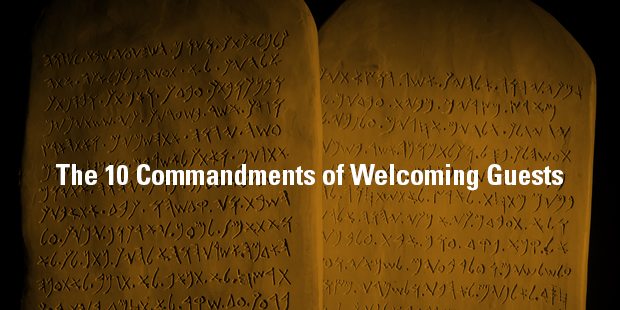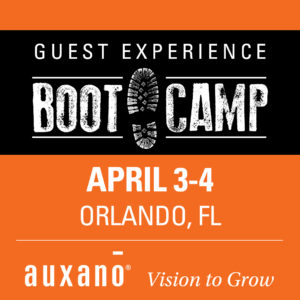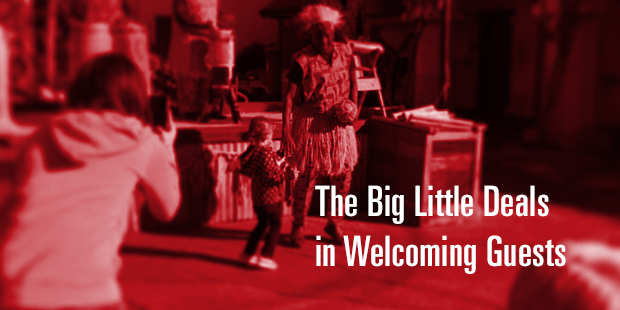
The 10 Commandments of Welcoming Guests
Editors Note: During our August focus on Guest Experiences, we are honored to have some of the best voices in the world of Customer Experience provide guest posts for the Vision Room. As you read the content below, simply think “Guest” where you see the word “customer” – and you will benefit from the knowledge and expertise of some great minds.
Are you following the 10 Commandments of Customer Experiences? Or is it time for a confession?
In May 2016, I spoke at CallidusCloud Connections (C3); if you’ve never been to this event, be sure to check it out this year! The topic of my session was The 7 Deadly Sins of Customer Experience. With the topic of today’s blog post, I seem to be on a bit of a spiritual customer experience journey.
In thinking about the customer experience, there are at least 10 Commandments that must be adhered to as you embark on your customer experience journey. These are essentials to ensure a successful customer experience transformation. Here’s what I’ve come up with, in no particular order.
1. Thou shalt listen to customers and act on their feedback.
This is probably two commandments, but you really can’t do one without the other. Listening to customers is, without a doubt, important to designing a great experience and to business success. Without understanding customers, their expectations, and how well we perform against those expectations, we can never correctly or appropriately redesign the experience to meet their needs. But too many companies forget that the “work” doesn’t end with listening. It’s only just begun! You must act on what you hear.
2. Thou shalt map the customer journey in order to understand the experience.
You can’t transform something you don’t understand. If you don’t know and understand what the current state of the customer experience is, how can you possibly design the desired future state? Take the time to map it, and make sure you map it so that it’s actionable: map it from the customer’s viewpoint and be sure to bring in artifacts and data that bring the journey to life.
3. Thou shalt put employees more first.
The link between the employee experience and customer experience is real. And yet, many companies still refuse to make the employee experience a priority, focusing instead on shareholder value, the bottom line, or customer experience without considering the implications a poor employee experience has on all of the above. Yes, you’re in business to create and nurture customers. But without your employees, you have no customer experience. If employees aren’t happy, satisfied, and engaged, it will be very difficult for them to delight your customers. This is known as the spillover effect, i.e., “the tendency of one person’s emotions to affect how other people around him feel.”
4. Thou shalt define and communicate the brand promise.
A brand promise is, well, a promise to your customers. Everything you do should reflect this promise. It sets expectations and defines the benefits customers can expect to receive when they engage in your services or use your products, when they experience your brand. It’s not a mission statement or a brand position. It’s meant for employees and customers. Employees at all levels live the promise and deliver on it. In order for employees to deliver on it, they must know it, i.e., it must be clearly communicated to them and reiterated often.
5. Thou shalt hire for attitude and train for skill.
Hiring the right people for your company is always a challenge, but it’s critical. Get the right people in the door – not just those folks who fit your culture or your values but also those who truly want to be there, for the right reasons. Define what “right” means for your company. And when you have the right people, they will attract other “right people.” While you need to define what your culture fit looks like, typically hiring people who are positive, passionate about what you do and what the role entails, and love talking to and being around people will set you on a good path. With enthusiasm and passion for the brand, employees are eager to work hard and do what it takes to contribute to, and ensure, its success.
6. Thou shalt not covet thy neighbor’s experience.
Imitation is the death of innovation. When imitating, there’s no need for innovation, right? Get motivated by what your competitors are doing, but don’t dwell on them. Don’t try to be just like them; nobody wins when you imitate. Instead, competition drives innovation, and vice versa. And innovation drives success, simply because it allows you and your competitors to offer a variety of products to meet your customers’ varying needs. When that happens, the customer wins. And then you do, too.
7. Thou shalt not proceed without getting executive commitment.
If your executives aren’t on board with developing a customer-focused and customer-centric organization, then forget it; it won’t happen. You might have localized or departmentalized efforts, but those will be siloed efforts that translate to siloed experiences for the customer. You must have global, cross-functional executive commitment; and most importantly, the CEO will lead the charge. Just know that, without executive commitment, you’ll never get resources – human, capital, or other – to execute on your customer experience strategy.
8. Thou shalt empower employees.
What does it mean to empower employees? Empowerment is all about responsibility, ownership, and accountability. It’s also about trust; the employee is given the keys to the castle and trusted to do what’s right for the customer and for the business. Empowerment means they never have to ask, “Is it OK if I do this for my customer?” Empowerment means not having to ask for permission. Because employees know. And why do they know? See the next commandment…
9. Thou shalt define a purpose, vision, and strategy.
Your purpose is your why. Why do you do what you do. Your vision is where you’re headed; the corporate vision must be aligned with the CX vision. The CX vision will be inspirational and aspirational; it will outline what you see as the future state of the customer experience. It will briefly describe the experience you plan to deliver. And it will serve as a guide to help choose future courses of action. Your strategy is how you’ll go about delivering on that vision.
10. Thou shalt communicate, communicate, communicate.
This one seems like such a no-brainer, but it’s one thing that folks need to be reminded of regularly: communication is critical to the successful execution of organizational and customer experience transformations. Communication is a key leadership skill that must be mastered. With communication, we can instruct, motivate, convince and align the audience, drive open and candid discussions, share, and set expectations. It’s the most valuable tool in any relationship.
Bonus. Thou shalt kill bad policies and rules.
There’s one more commandment that I thought was worth adding as a bonus. In order to transform the organization and the experience, it’s imperative that we lose the “we’ve always done it that way” frame of mind. Question everything. Is there a better way to do something? Is there a stupid rule or policy in place whose origin cannot be recalled by anyone? Are there rules that make it painful for customers to do what it is that they’re trying to do? Are bad policies making it painful for employees to do their jobs well or to deliver the desired customer experience? Never let “that’s just how it’s always been done” get in the way of doing things more efficiently and with less effort.
Without a doubt, there are more customer experience commandments! Perhaps I’ll write about others in a future post. How many of these commandments have you fallen short on?
Some rules are nothing but old habits that people are afraid to change. -Therese Anne Fowler

Want to learn how to create an EXCEPTIONAL Guest Experience at your church? Check out Auxano’s Guest Experience Boot Camp, coming to Orlando, FL on April 3-4.

Tags: Annette Franz, Church Guest Experienc, Guest Experience, Welcoming Guests
















